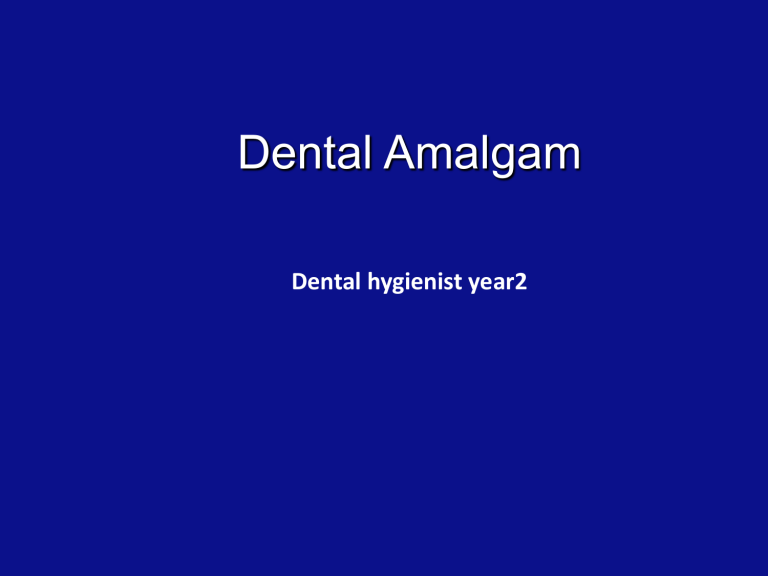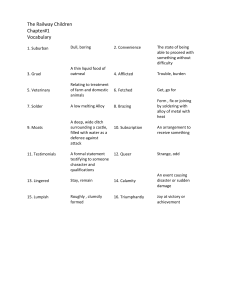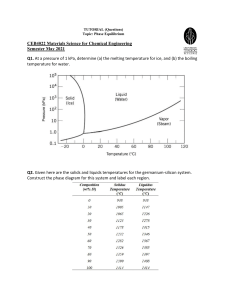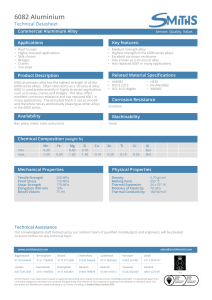
Dental Amalgam Dental hygienist year2 Overview • • • • • • History Basic composition Basic setting reactions Classifications Manufacturing Variables in amalgam performance History • DENTAL AMALGAM or SILVER AMALGAM is a special type of alloy that contains mercury as one of its constituents (Ag; Cu; Sn; and sometimes Zn). • Silver Amalgam has been in use as a VERSATILE restorative material since the beginning of 19th century. • The first dental silver amalgam was introduced into England by “Joseph Bell” in 1819 and was known as “BELLS PUTTY”. • SIR REGNART because of his extensive study is considered as the FATHER OF AMALGAM History • 1833 – Crawcour brothers introduce amalgam to US • powdered silver coins mixed with mercury – expanded on setting • 1895 – G.V. Black develops formula for modern amalgam alloy • 67% silver, 27% tin, 5% copper, 1% zinc – overcame expansion problems History • 1960’s – conventional low-copper lathe-cut alloys • smaller particles – first generation high-copper alloys • Dispersalloy (Caulk) – admixture of spherical Ag-Cu eutectic particles with conventional lathe-cut – eliminated gamma-2 phase Mahler J Dent Res 1997 History • 1970’s – first single composition spherical • • Tytin (Kerr) ternary system (silver/tin/copper) • 1980’s – alloys similar to Dispersalloy and Tytin • 1990’s – mercury-free alloys Mahler J Dent Res 1997 Why Amalgam? • Ease of manipulation. • Less cost. • Less time required. • Long clinical track record > 100 years Whereas resin based composites are: • More technique sensitive. • Less durability. • Post-operative sensitivity. • Microleakage. • Secondary caries. Constituents in Amalgam • Basic – – – – Silver Tin Copper Mercury • Other – Zinc – Indium – Palladium Basic Constituents • Silver (Ag) – increases strength – increases expansion • Tin (Sn) – decreases expansion – decreased strength – increases setting time Phillip’s Science of Dental Materials 2003 Basic Constituents • Copper (Cu) – ties up tin • reducing gamma-2 formation – increases strength – reduces tarnish and corrosion – reduces creep • reduces marginal deterioration Phillip’s Science of Dental Materials 2003 Basic Constituents • Mercury (Hg) – activates reaction – only pure metal that is liquid at room temperature – spherical alloys • require less mercury Click here for ADA Mercury Hygiene Recommendations – smaller surface area easier to wet » 40 to 45% Hg – admixed alloys • require more mercury – lathe-cut particles more difficult to wet » 45 to 50% Hg Phillip’s Science of Dental Materials 2003 Other Constituents • Zinc (Zn) – used in manufacturing • decreases oxidation of other elements – sacrificial anode – provides better clinical performance • less marginal breakdown – Osborne JW Am J Dent 1992 – causes delayed expansion with low Cu alloys • if contaminated with moisture during condensation – Phillips RW JADA 1954 H2O + Zn Þ ZnO + H2 Phillip’s Science of Dental Materials 2003 Other Constituents • Indium (In) – decreases surface tension • reduces amount of mercury necessary • reduces emitted mercury vapor – reduces creep and marginal breakdown – increases strength – must be used in admixed alloys – example • Indisperse (Indisperse Distributing Company) – 5% indium Powell J Dent Res 1989 Other Constituents • Palladium (Pd) – reduced corrosion – greater luster – example • Valiant PhD (Ivoclar Vivadent) – 0.5% palladium Mahler J Dent Res 1990 Classifications •Copper content = low copper, high copper •Particle size (and shape) = irregular or lathecut, spherical, admixed •Number of particle types = 1 or 2 •Zinc content = Zn-containing, Zn-free Lathecut Spherical Admixed Manufacturing Process • Lathe-cut alloys – – Ag & Sn melted together alloy cooled • – heat treat • – – phases solidify 400 ºC for 8 hours grind, then mill to 25 - 50 microns heat treat to release stresses of grinding Phillip’s Science of Dental Materials 2003 Manufacturing Process • Spherical alloys – – melt alloy atomize • – spheres form as particles cool sizes range from 5 - 40 microns • variety improves condensability Phillip’s Science of Dental Materials 2003 Basic Composition • A silver-mercury matrix containing filler particles of silver-tin • Filler (bricks) – Ag3Sn called gamma • can be in various shapes – irregular (lathe-cut), spherical, or a combination • Matrix – Ag2Hg3 called gamma 1 • – cement Sn8Hg called gamma 2 • voids BEFORE REACTION Alloy Mercury AFTER REACTION Alloy Reaction Products • Upon mixing the mercury begins to dissolve and react with the outer layers of the Ag-Sn particles (which are generally polycrystalline). • About 15% of the Ag-Sn particles are consumed to produce complete reaction of the Hg and generate a matrix of solid reaction products. • The primary product is composed of Ag-Hg. The unreacted alloy particles remain embedded within the matrix and contribute mechanical reinforcement. Basic Setting Reactions • Conventional low-copper alloys • Admixed high-copper alloys • Single composition high-copper alloys Conventional Low-Copper Alloys • Dissolution and precipitation • Hg dissolves Ag and Sn from alloy • Intermetallic compounds formed Ag-Sn Alloy Hg Hg Ag Ag Ag Sn Sn Ag-Sn Ag-Sn Alloy Alloy Mercury (Hg) Sn Ag3Sn + Hg Þ Ag3Sn + Ag2Hg3 + Sn8Hg g g g1 g2 Phillip’s Science of Dental Materials 2003 Conventional Low-Copper Alloys • Gamma (g) = Ag3Sn – – – Hg unreacted alloy strongest phase and corrodes the least forms 30% of volume of set amalgam Ag-Sn Alloy Hg Hg Ag Ag-Sn Alloy Sn Ag Ag Sn Sn Mercury Ag-Sn Alloy Ag3Sn + Hg Þ Ag3Sn + Ag2Hg3 + Sn8Hg g g g1 g2 Phillip’s Science of Dental Materials 2003 Conventional Low-Copper Alloys • Gamma 1 (g1) = Ag2Hg3 – – – matrix for unreacted alloy and 2nd strongest phase 10 micron grains binding gamma (g) 60% of volume Ag-Sn Alloy g1 Ag-Sn Alloy Ag-Sn Alloy Ag3Sn + Hg Þ Ag3Sn + Ag2Hg3 + Sn8Hg g g g1 g2 Phillip’s Science of Dental Materials 2003 Conventional Low-Copper Alloys • Gamma 2 (g2) = Sn8Hg – – – – – weakest and softest phase corrodes fast, voids form corrosion yields Hg which reacts with more gamma (g) 10% of volume volume decreases with time due to corrosion Ag3Sn + Hg Þ Ag3Sn + Ag2Hg3 + Sn8Hg g g g1 g2 Phillip’s Science of Dental Materials 2003 Admixed High-Copper Alloys • Ag enters Hg from Ag-Cu spherical eutectic particles – eutectic • • Ag-Cu Alloy an alloy in which the elements are completely soluble in liquid solution but separate into distinct areas upon solidification Both Ag and Sn enter Hg from Ag3Sn particles Hg Ag Ag Ag Ag-Sn Alloy Sn Mercury Hg Ag Sn Ag-Sn Alloy Ag3Sn + Ag-Cu + Hg Þ Ag3Sn + Ag-Cu + Ag2Hg3 + Cu6Sn5 g g g1 h Phillip’s Science of Dental Materials 2003 Admixed High-Copper Alloys • Sn diffuses to surface of Ag-Cu particles – h Ag-Cu Alloy reacts with Cu to form (eta) Cu6Sn5 (h) • around unconsumed Ag-Cu particles Ag-Sn Alloy Ag-Sn Alloy Ag3Sn + Ag-Cu + Hg Þ Ag3Sn + Ag-Cu + Ag2Hg3 + Cu6Sn5 g g g1 h Phillip’s Science of Dental Materials 2003 Admixed High-Copper Alloys • Gamma 1 (g1) (Ag2Hg3) surrounds (h) eta phase (Cu6Sn5) and gamma (g) alloy particles (Ag3Sn) h Ag-Cu Alloy Ag-Sn Alloy g1 Ag-Sn Alloy Ag3Sn + Ag-Cu + Hg Þ Ag3Sn + Ag-Cu + Ag2Hg3 + Cu6Sn5 g g g1 h Phillip’s Science of Dental Materials 2003 Single Composition High-Copper Alloys • Gamma sphere (g) (Ag3Sn) with epsilon coating (e) (Cu3Sn) • Ag and Sn dissolve in Hg e Ag-Sn Alloy Ag Sn Ag-Sn Alloy Sn Ag Ag-Sn Alloy Mercury (Hg) Ag3Sn + Cu3Sn + Hg Þ Ag3Sn + Cu3Sn + Ag2Hg3 + Cu6Sn5 g e g e g1 h Phillip’s Science of Dental Materials 2003 Single Composition High-Copper Alloys • Gamma 1 (g1) (Ag2Hg3) crystals grow binding together partiallydissolved gamma (g) alloy particles (Ag3Sn) h • Epsilon (e) (Cu3Sn) develops crystals on surface of gamma particle (Ag3Sn) in the form of eta (h) (Cu6Sn5) – – Ag-Sn Alloy Ag-Sn Alloy Ag-Sn Alloy g1 reduces creep prevents gamma-2 formation Ag3Sn + Cu3Sn + Hg Þ Ag3Sn + Cu3Sn + Ag2Hg3 + Cu6Sn5 g e g e g1 h Phillip’s Science of Dental Materials 2003 Hg / Alloy RATIOS 50:50 42:58 ALLOY MANIPULATION Manual Trituration Procedures: Alloy + Hg ® mortar + pestle Mechanical Trituration Procedures: Powdered alloy + Hg ® capsule + pestle Pelleted alloy + Hg ® capsule + pestle Powdered alloy + Hg ® manual mixing ® amalgamator ® amalgamator ® pre-capsulated ® amalgamator Overview of Manipulation Placement and Condensation TIME Onset of MIXING Onset of WORKING Carving Onset of SETTING Burnishing End of SETTING Selection / Proportioning / Amalgamation / Manipulation / Polishing Polishing 24 hours Mechanical Properties 1. Strength a) Compressive b) Tensile 2. Creep 3. Dimensional Change Mechanical Properties STRENGTH: Ø High compressive strength (300MPa min, range 380 to 550 MPa), but low tensile strength and low shear strength, it is a brittle material so: – Enough bulk of amalgam is needed to provide enough strength. – Requires support from surrounding tooth structure Ø High copper amalgam and spherical alloy amalgams have higher strength values after the first hour of placement than conventional lathe-cut amalgams Mechanical Properties CREEP Ø Creep is a slow change in shape caused by compression due to dynamic intra-oral stresses. Creep causes amalgam to flow, such that unsupported amalgam protrudes from the margin of the cavity. Ø The lower the creep value of an amalgam, the better the marginal integrity of the restoration. Ø Alloys with high copper content usually have lower creep values than the conventional silvertin alloys. Mechanical Properties Creep Mechanical Properties DIMENSIONAL CHANGE: Ø The net contraction or expansion of an amalgam is called its dimensional change. Ø Dimensional change is negative if the amalgam contracts and positive if it expands during setting. Ø ANSI/ ADA specification No.1 requires that the dimensional change be an expansion or a contraction of no more than 20µm/cm. Mechanical Properties DIMENSIONAL CHANGE: Ø During amalgamation reaction, expansion and contraction occur simultaneously. Ø Dissolution of γ particles contraction, Ø formation of γ-1 expansion. Ø The overall dimensional change is therefore the sum of these two processes. Mechanical Properties Ø Dimensional change is affected by many factors, such as ü ü ü ü Moisture contamination Particle size and shape Type of the alloy Manipulation : mercury/alloy, trituration and condensation Mechanical Properties Dimensional Change: Delayed Excessive Expansion ? Zinc – containing alloy + Moisture. Dimensional Change Thermal Properties ØAmalgam has high thermal conductivity: In large cavities an insulator is needed underneath amalgam to protect the pulp ØCoefficient of Thermal Expansion is 3 times that of dentine so, expansion and contraction occur and may lead to microleakage Chemical Properties • Tarnish (chemical corrosion) • Tarnishing simply involves the loss of luster from the surface of a metal or alloy due to formation of a surface sulphide layer coating. • The integrity of the alloy is not affected and so no change in mechanical properties is expected. • Ag+1 + S-2 -------> Ag2S (black film) Clinical example of tarnished occlusal surface of amalgam restoration. Chemical Properties • Electrochemical corrosion : – occurs whenever chemically different sites act as an anode and cathode – has the potential to occur virtually anywhere on or within a set amalgam. • Galvanic corrosion: – Contact between two dissimilar metals , such as an amalgam restn and a gold crown • Galvanic corrosion can occur at microscopic level as well, because of the electrochemical differences of different phases in the alloy. Chemical Properties • Ag-Sn particles act as the strongest cathodes. Sn-Hg or Cu-Sn reaction product phases are the strongest anodes, Local cells are formed and corrosion starts. • Cracks and crevices produce similar conditions and preferentially corrode (concentration cell corrosion or crevice corrosion). • Regions under stress also display a greater propensity for corrosion (stress corrosion) Biological properties • Research showed conflicting results as to the systemic effect of mercury in amalgam • Body maybe exposed to higher amounts during placement, polishing, corrosion and removal of amalgam fillings • Systemic effects related to mercury (no strong evidence): – Mild behavioral problem, major psychiatric problems, multiple sclerosis – Fetal damage and abortions Biological Properties • One possible effect is allergic reaction to mercury: – Contact dermatitis – Lichenoid reactions • This sensitivity is usually due to prior sensitization of patients to mercury present in some medicines Biological Properties • Dentists and assistants are mainly in danger from mercury (vapor) exposure during amalgam condensation, placement, removal, amalgam or mercury spells, improper disposal of amalgam scraps, carpeted or tile floors in clinics. • Increase in temperature increases mercury vapor pressure so never sterilize instruments unless they are cleaned from any amalgam remnants 53 Mercury safety • Safety should be considered for: – Patient – Operator – Environment • How does mercury enter the human body? – Skin contact – Vapor inhalation – Ingestion To protect the patient: – Use high volume suction – Rubber dam isolation 54 Safety procedures Adequate ventilation Avoid heating instruments to>80°C Floors should be nonporous and easy to clean Use gloves, masks, glasses Amalgam scrap stored under water of film fixer in airtight containers • Recycling of amalgam scrap appropriately • • • • • 55 Continued, • Reduction of mercury vapor: – Use amalgam capsules – Use amalgamator with enclosed mixing arm – Store amalgam scrap under spent radiographic fixer – Clean instruments from any amalgam before sterilization – Avoid ultrasonic condensers – Clean mercury spills promptly with spill kit 56 CLASS I & II AMALGAM RESTORATIONS Class I Restorations • All pit-and-fissure restorations are Class I and they include defects on the: Ø occlusal surface of posterior teeth, Øthe occlusal two thirds of the facial and lingual surface of molars, and Øthe lingual surfaces of maxillary anterior teeth. CLINICAL TECHNIQUE • Initial Clinical Procedures. Local anaesthesia administration, Rubber dam isolation, • Tooth Preparation. – Initial tooth preparation – Final tooth preparation • Restorative Technique – – – – – – Selection of alloy Mixing/ trituration Condensation Carving Burnishing Finishing and polishing Tooth Preparation • Initial Tooth Preparation. • “defined as establishing the outline form by extension of the external walls to sound tooth structure, while maintaining a specified, limited depth and providing resistance and retention forms.” Definition : Establishing the outline form means 1) Placing the preparation margins in the positions they will occupy in the final preparation except for finishing enamel walls and margins. 2) Preparing an initial depth of 0.2 to 0.5mm pulpally of the DEJ position Outline form • The outline form for the Class I occlusal amalgam tooth preparation should include only the faulty, defective occlusal pits and fissures Rules For Establishing Outline Form For Pit-andFissure Tooth Preparation. 1. Extend the preparation margin until the sound tooth structure is obtained, and no unsupported or weakened enamel remains. 2. Avoid terminating the margin on extreme eminences, such as cusp heights or ridge crest. 3. If the extension from a primary groove includes one half or more of the cusp incline, consideration should be given to capping the cusp. 4. Extend the preparation margin to include all of the fissure that cannot be eliminated by appropriate enameloplasty. 5. Restrict the pulpal depth of maximum of 0.2 mm into dentin. 6.When 2 pit and fissure preparations have less than 0.5mm of sound tooth structure between them, then should be joined to eliminate a weak enamel wall between them. 7.Extend the outline form to provide sufficient access for proper tooth preparation, restoration placement and finishing procedure. Examples of Class I amalgam tooth preparation outline forms Resistance And Retention • Principles ØTo use the box shape with flat pulpal floor. ØTo restrict the extension of the external walls. ØTo provide enough thickness of restorative material to prevent its fracture under load. ØRounded internal line angles. ØBond the material to the tooth. ØWidth of the cavity-1/4th intercuspal distance Ø The parallelism or slight occlusal convergence of two or more opposing, external walls provides the primary retention form. Final Tooth Preparation. • Final tooth preparation includes: (1) removal of remaining defective enamel and infected dentin on the pulpal floor; (2) pulp protection, where indicated; (3) procedures for finishing external walls; and (4) final procedures of cleaning and inspecting the prepared tooth. Base application: thickness of 0.5 to 0.75 mm is indicated CLASS II AMALGAM RESTORATIONS Restorations on the proximal surfaces of posterior teeth are Class II. ( G.V. Black) According to Marzouk :Class II cavity preparation is the proximal, Proximo-facial(lingual), proximo-occlusal or (combination there of) tooth preparation. It is part of mechano-therapy for smooth surface lesion, involving the proximal surfaces of molars and premolars. Successful class II restoration needs • Correct tooth preparation • Operating field isolation • Suitable matrix selection and correct placement • Proper manipulation of the restorative material. • Class II silver amalgam preparations will vary with the morphology, anatomy and extent of carious involvement of the individual tooth being restored. However, certain fundamentals are common to all Class II silver amalgam cavity preparations. • The Class II silver amalgam cavity preparation consists of: • A- Occlusal segment and • B- Proximal segment: The Occlusal Segment • Outline Form: • is similar to that for the Class I tooth preparation except that the external outline is extended proximally toward defective proximal surface. • The occlusal outline form in the region of the proximal box is determined primarily by the bucco-lingual position of the contact and the extent of the carious lesion. • The occlusal outline at the proximal marginal ridge(s) must be extended enough to make breaking of the contact with the adjacent tooth easy. The Proximal Segment -Proximal outline form should: • Include all caries, faults, or existing restorative material. • Create 90-degree cavosurface margins (i.e., butt joint margins). • Establish (ideally) not more than 0.5 mm clearance with the adjacent proximal surface facially, lingually, and gingivally 0.5 Preparation of Proximal Box • Proximal ditch cut: At the proximal DEJ cut a ditch gingivally along the exposed DEJ, two thirds at the expense of dentin and one third at the expense of enamel. • The 0.8-mm diameter bur end will cut approximately 0.5 to 0.6 mm into dentin and 0.2 to 0.3 mm into enamel. • Extend the ditch gingivally just beyond the caries or the proximal contact, whichever is greater The proximal ditch cut should be sufficiently deep into dentin (i.e., 0.5 to 0.6 mm) that retention locks, if deemed necessary, can be prepared into the axiolingual and axiofacial line angles without undermining the proximal enamel. Resistance Principles ØTo use the box shape with flat pulpal floor. ØTo restrict the extension of the external walls. ØTo provide enough thickness of restorative material to prevent its fracture under load. ØRounded internal line angles. ØTo cap weak cusps and envelope or include enough of a weakened tooth. ØBond the material to the tooth. ØWidth of the cavity-1/4th intercuspal distance . Retention • Primary retention form is provided by the occlusal convergence of facial and lingual walls and by the dovetail design of the occlusal step • Secondary resistance and retention by: – Beveling of axiopulpal line angles – Gingival beveling with GMT – Placements of retention locks Gingival bevel with GMT 200 Beveling of the axiopulpal line angle Proximal retention locks Box-only Preparation • Recommended when- a small, cavitated, proximal lesion in a tooth with neither occlusal fissures nor a previously inserted occlusal restoration. Class II Amalgam Restorations Involving Both Proximal Surfaces (MOD) • The tooth preparation techniques are the same except certain modifications in tooth preparation may be necessary and the use of an amalgam-bonding system may be more strongly considered. Occlusal extensions. • Often a larger Class II defect will require: ØExtending grooves that are fissured ØCapping cusps that are undermined ØExtending the outline form up the cuspal inclines Groove extensions Cusp capping • When the occlusal outline form extends from a primary groove to within two thirds (2/3rd)of the distance to a cusp tip, cusp should be replaced or capped. C U S P C A P P I N G Cusp reduction for an amalgam restoration should result in a uniform amalgam thickness over the reduced cusp of 1.5 to 2 mm. The thicker amount is necessary for functional cusps Proximal Extensions • MOD preparations often require larger proximal box preparations. • Large proximal box preparations also need secondary retention features (i.e., retention locks, pins, slots) for adequate retention form. • Extension around a facial or lingual line angle may be needed. • When proximal extension around a line angle is necessary, it is usually associated with a reduction of the involved cusp. Proximal extension around a line angle is associated with a reduction of the involved cusp Pulp Protection • Approximately 2 mm of dentin, or an equivalent thickness of material, should exist to protect the pulp. • This thickness is not always possible, but 1 to 1.5 mm of insulation is accepted as a practical thickness. • As the tooth preparation extends closer to the pulp, a thick liner or a base is used to augment dentin to the proper thickness range. Liners • Liners are relatively thin layers of material used primarily to provide a barrier to protect the dentin from residual reactants diffusing out of a restoration and/or oral fluids that may penetrate leaky tooth-restoration interfaces. • They also contribute initial electrical insulation; generate some thermal protection; and, in some formulations, provide pulpal treatment as well • Traditional liners are now mostly replaced by dentin bonding agents. Liners provide: (1) a barrier that protects the dentin from noxious agents from either the restorative material or oral fluids (2) initial electrical insulation (3) Pulpal medication and/or (4) some thermal protection Liners • Nowadays liners are used only when “the tooth preparation is extremely close to the pulp and pulpal medication becomes a concern” Thin film liners (1 to 50 μm) Solution liners (2 to 50 μm) Cement liners (200 to 1000 μm) (0.2 to 1 mm) Needed for pulpal medication Varnishes Suspension liners Varnishes • Most varnish coatings are produced by drying solutions of copal or other resin dissolved in a volatile solvent. • Composition: 10% copal resin in a combination of ether, alcohol, and acetone • When applied the solvent evaporates in 8-10s and a thin film of resin is produced. • A single coat effectively covers only 55% of the surface • A second thin layer is recommended to produce sealing of 80% to 85% of the surface. Suspension liners • Suspension liners produce the same effect, but dry more slowly and produce thicker films. (20 to 25 µm) Cement liners • Those aqueous suspensions or dispersions of zinc oxide or calcium hydroxide that can be applied to a tooth surface in a relatively thin films' and are used to affect a particular pulpal response. (200-1000µm) Bases • Bases are considered those cements commonly used in thicker dimensions beneath permanent restorations to provide for mechanical, chemical, and thermal protection of the pulp. • zinc phosphate; • zinc oxide-eugenol; • calcium hydroxide; • polycarboxylate; • some type of glass ionomer. • the level to which a base is built should never compromise the desired tooth preparation depth, resulting in inadequate restorative material thickness. • Base Materials should provide “maximum strength in minimum thickness” Guidelines • • • • • When remaining dentin thickness (RDT) is RDT ≥ 2mm Varnish or DBA RDT< 1.5mm solution liner or DBA RDT < 0.5 mm CaOH liner + Base Near or actual Pulp exposure: a 1-mm thickness of calcium hydroxide overlaid with a base





